parking brake lexus LFA 2012 Technical Information / LEXUS 2012 LFA: INSIDE THE LFA
[x] Cancel search | Manufacturer: LEXUS, Model Year: 2012, Model line: LFA, Model: Lexus LFA 2012Pages: 128, PDF Size: 5.91 MB
Page 11 of 128

9
Basic operations
1 Reverse selector switch
Pull the switch to select Reverse (R).
2 Paddle shift switches ("P. 40)
Pull the right paddle shift switch to upshift and the left paddle shift switch to
downshift. Pull both paddle shift switches at once to select Neutral (N).
3 Control pad ("P. 66)
4 “ENGINE START” switch
5 Driving mode selector switch ("P. 26)
6 AUTO driving mode button ("P. 27)
7 Shift speed selector ("P. 41)
Allows the driver to choose their desired shift speeds for the manually shifted
SPORT, NORMAL, and WET driving modes.
8 Parking brake switch
9 Ignition switch
10 Accelerator pedal ("P. 32)
11 Tilt and telescopic steering lock release lever
12 Brake pedal ("P. 50)
13 Hood release lever ("P. 12)
14 Rear hatch opener switch ("P. 12)
15 Fuel filler door opener switch ("P. 12)
16 Outside rear view mirror switches
17 VSC off switch
Turns VSC and TRAC off. Press the switch again to turn VSC and TRAC back on.
Page 13 of 128

11
Basic operations
■
■Starting off
1 With the brake pedal depressed, pull the right paddle shift switch to select 1st gear.
2 Pull the parking brake switch to release the parking brake.
3 Release the brake pedal and then slowly depress the accelerator pedal.
■
■Reversing
1 With the vehicle stationary, depress the brake pedal and check the gear indicator
in the meter to ensure that Neutral is selected.
2 Pull the reverse selector switch to select Reverse.
3 Release the brake pedal and then slowly depress the accelerator pedal.
It is not possible to change directly from Reverse to any of the forward gears. Select Neutral first
and then select a forward gear.
■
■Parking
1 Depress the brake pedal until the vehicle comes to a complete stop.
2 Press the parking brake switch to set the parking brake.
3 Ensure that “D1”, “1” or “R” is displayed on the gear indicator.
4 Push in the key and turn it to the “LOCK” position to stop the engine.
The “ENGINE START” switch is for starting the engine. It cannot be used to stop the engine.
Page 54 of 128
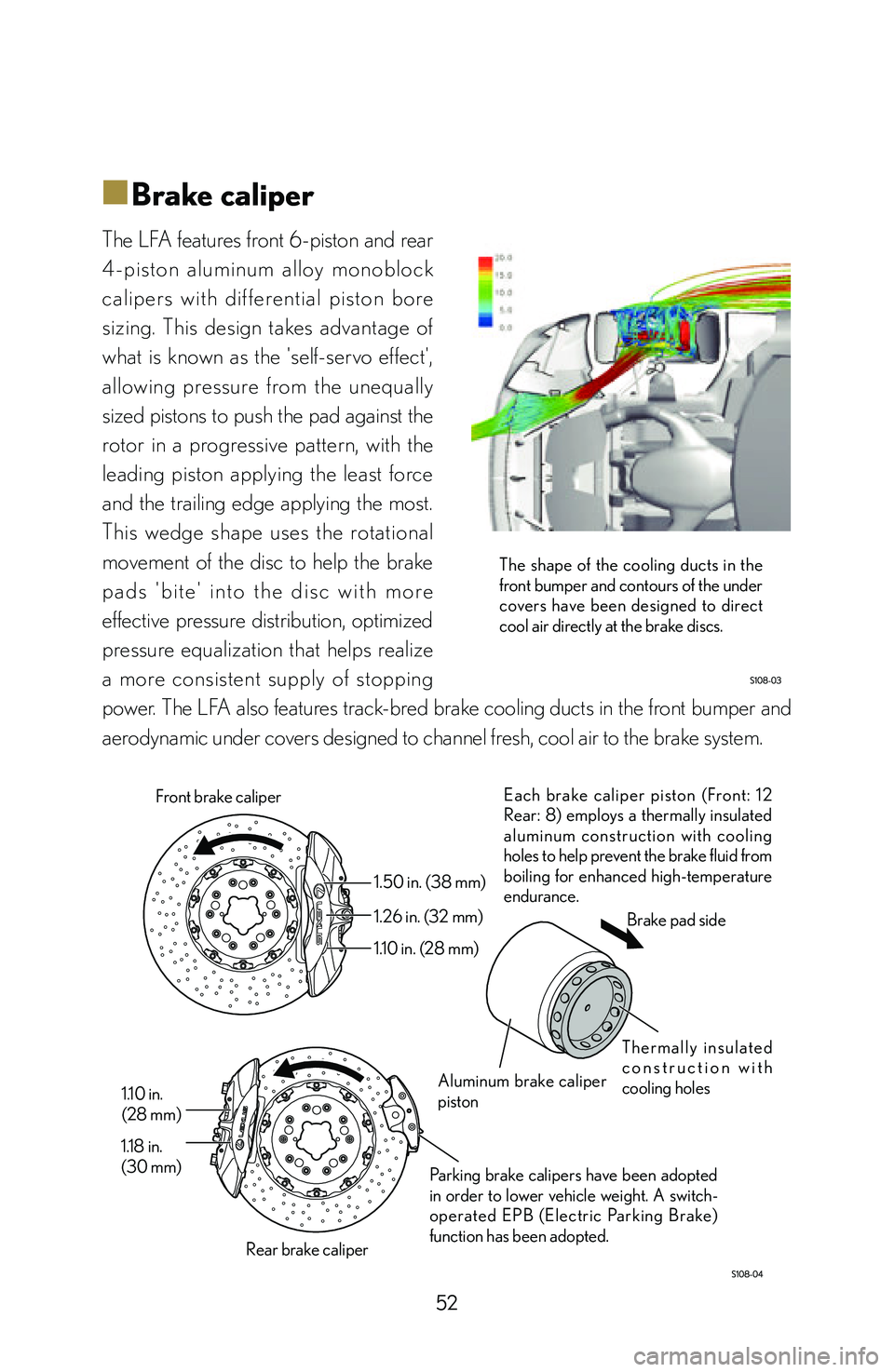
52
■
■Brake caliper
The LFA features front 6-piston and rear
4-piston aluminum alloy monoblock
calipers with dif ferential piston bore
sizing. This design takes advantage of
what is known as the 'self-servo effect',
allowing pressure from the unequally
sized pistons to push the pad against the
rotor in a progressive pattern, with the
leading piston applying the least force
and the trailing edge applying the most.
This wedge shape uses the rotational
movement of the disc to help the brake
p a d s ' b i t e ' i n t o t h e d i s c w i t h m o r e
effective pressure distribution, optimized
pressure equalization that helps realize
a more consistent supply of stopping
power. The LFA also features track-bred brake cooling ducts in the front bumper and
aerodynamic under covers designed to channel fresh, cool air to the brake system.
Each brake caliper piston (Front: 12
Rear: 8) employs a thermally insulated
aluminum construction with cooling
holes to help prevent the brake fluid from
boiling for enhanced high-temperature
endurance.
Parking brake calipers have been adopted
in order to lower vehicle weight. A switch-
operated EPB (Electric Parking Brake)
function has been adopted.
1.50 in. (38 mm)
1.26 in. (32 mm)
1.10 in. (28 mm)
1.10 in.
(28 mm)
1.18 in.
(30 mm) Front brake caliper
Rear brake caliper Aluminum brake caliper
piston
T h e r m a l l y i n s u l a t e d
c o n s t r u c t i o n w i t h
cooling holesBrake pad side
The shape of the cooling ducts in the
front bumper and contours of the under
covers have been designed to direct
cool air directly at the brake discs.
Page 94 of 128
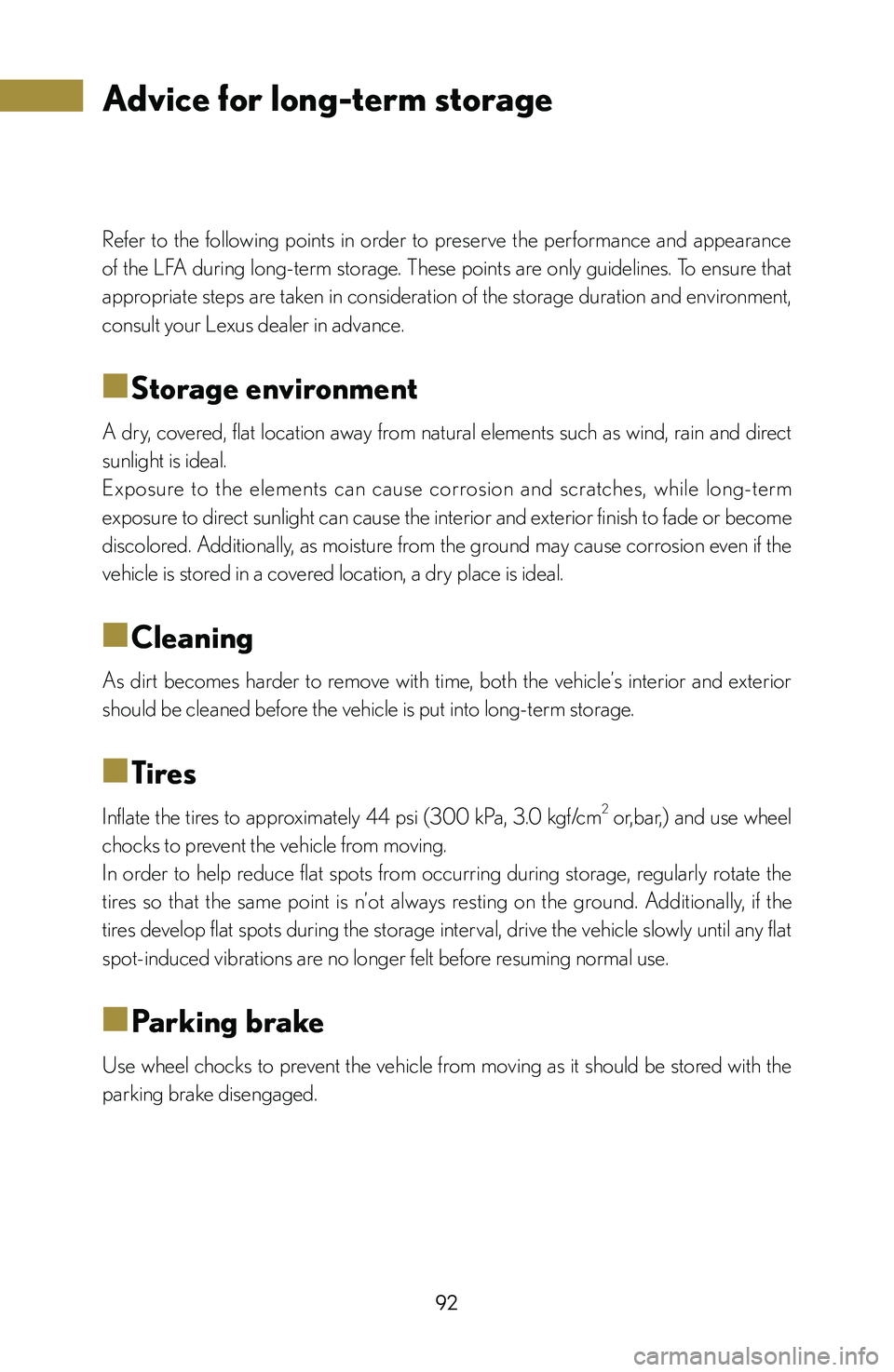
92
Refer to the following points in order to preserve the performance and appearance
of the LFA during long-term storage. These points are only guidelines. To ensure that
appropriate steps are taken in consideration of the storage duration and environment,
consult your Lexus dealer in advance.
■
■Storage environment
A dry, covered, flat location away from natural elements such as wind, rain and direct
sunlight is ideal.
Exposure to the elements can cause corrosion and scratches, while long-term
exposure to direct sunlight can cause the interior and exterior finish to fade or become
discolored. Additionally, as moisture from the ground may cause corrosion even if the
vehicle is stored in a covered location, a dry place is ideal.
■
■Cleaning
As dirt becomes harder to remove with time, both the vehicle’s interior and exterior
should be cleaned before the vehicle is put into long-term storage.
■
■Tires
Inflate the tires to approximately 44 psi (300 kPa, 3.0 kgf/cm2 or,bar,) and use wheel
chocks to prevent the vehicle from moving.
In order to help reduce flat spots from occurring during storage, regularly rotate the
tires so that the same point is n’ot always resting on the ground. Additionally, if the
tires develop flat spots during the storage interval, drive the vehicle slowly until any flat
spot-induced vibrations are no longer felt before resuming normal use.
■
■Parking brake
Use wheel chocks to prevent the vehicle from moving as it should be stored with the
parking brake disengaged.
Advice for long-term storage
Page 96 of 128
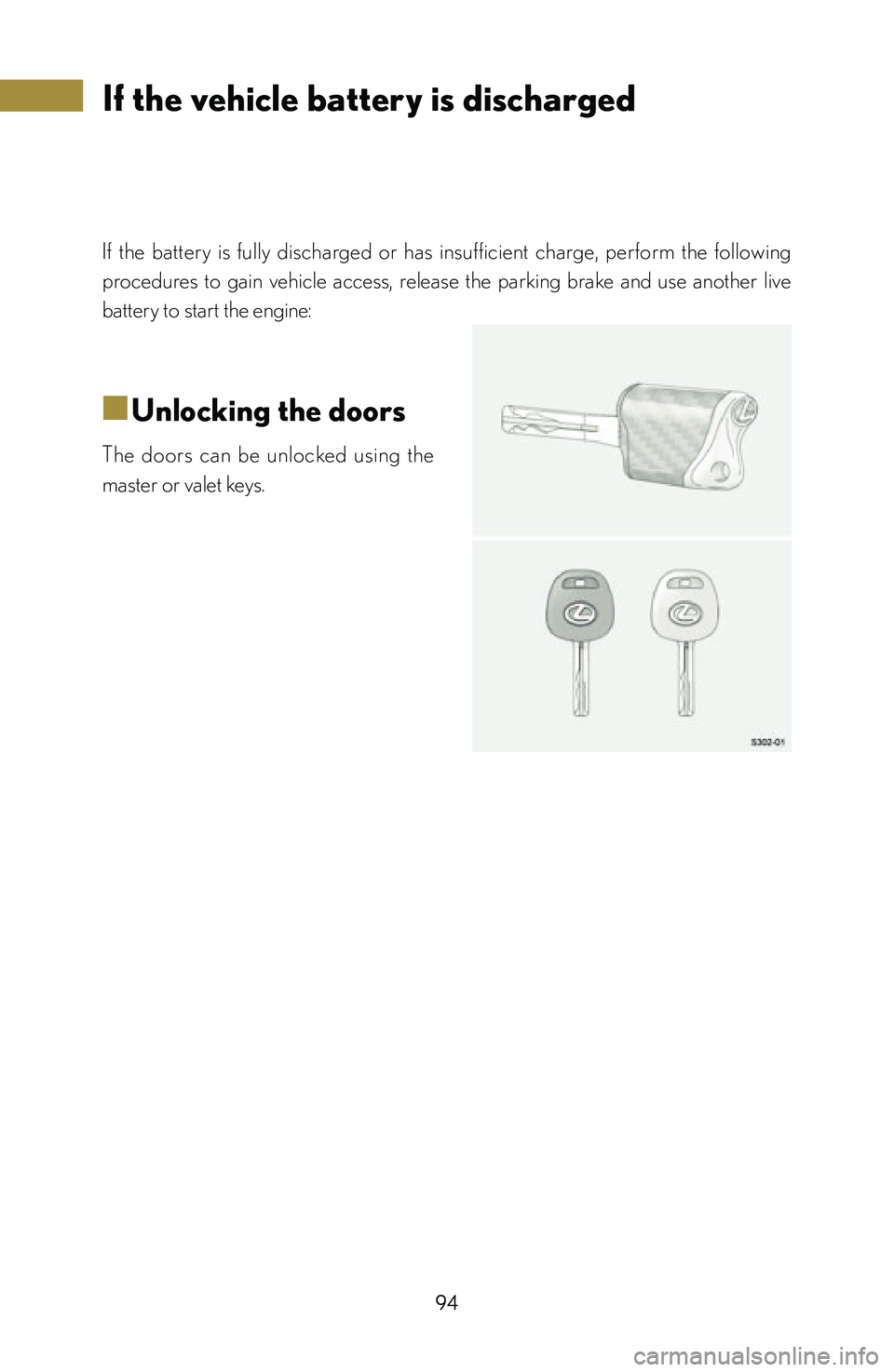
94
If the battery is fully discharged or has insufficient charge, perform the following
procedures to gain vehicle access, release the parking brake and use another live
battery to start the engine:
■
■Unlocking the doors
The doors can be unlocked using the
master or valet keys.
If the vehicle battery is discharged
Page 98 of 128

96
■
■Manually releasing the parking brake
Apply wheel chocks before manually releasing the parking brake.
1 Open the rear hatch and remove the
cover.
M a n u a l l y u n l o c k i n g t h e r e a r h a t c h
(
" P. 95)
2 Release the belt and take out the tool
bag.
Take the parking brake release tool and the
screwdriver handle out of the tool bag.
Page 99 of 128
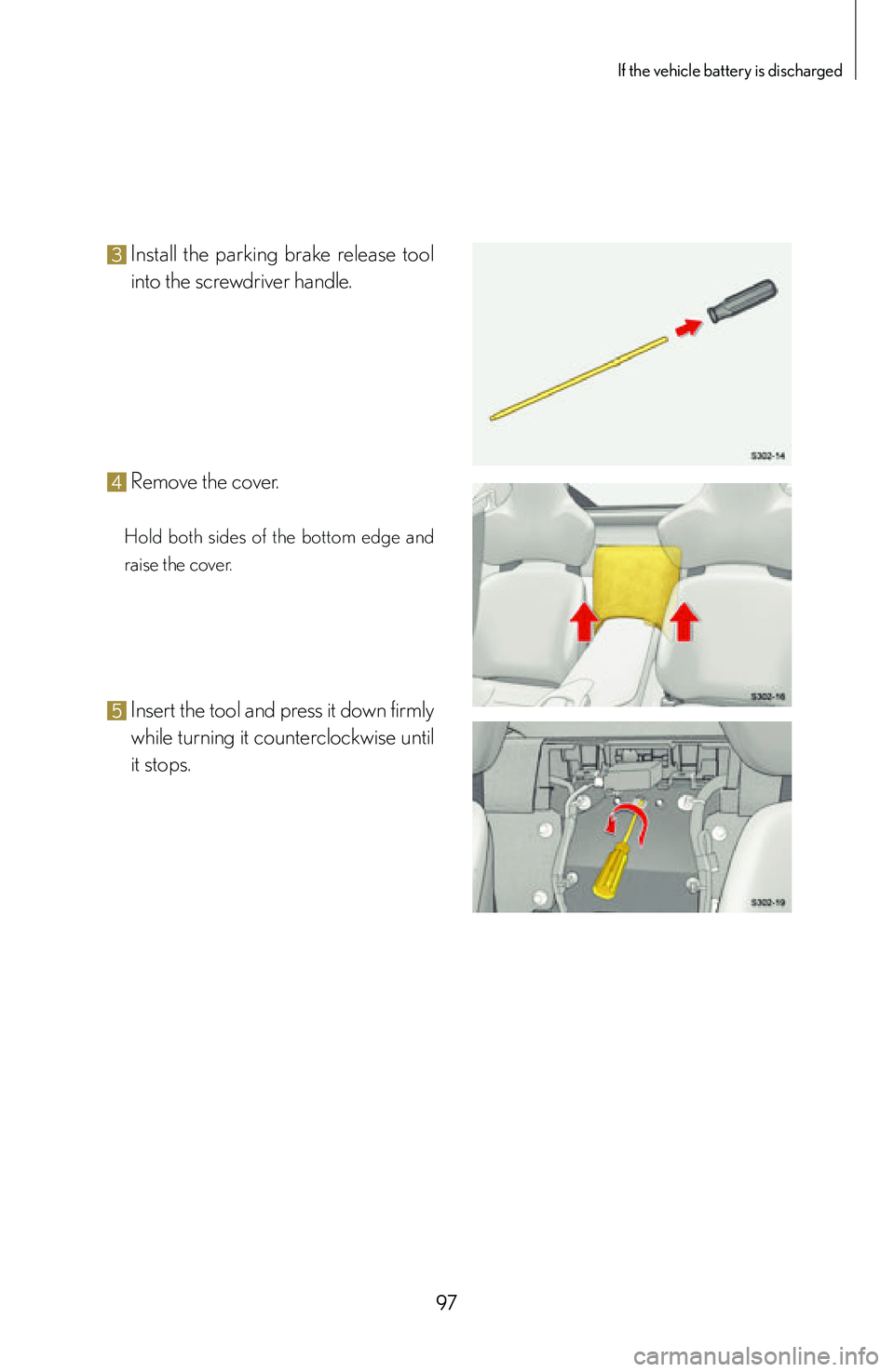
97
If the vehicle battery is discharged
3 Install the parking brake release tool
into the screwdriver handle.
4 Remove the cover.
Hold both sides of the bottom edge and
raise the cover.
5 Insert the tool and press it down firmly
while turning it counterclockwise until
it stops.
Page 104 of 128

102
7 Select Neutral, engage the parking
brake, and turn the ignition switch to
the “LOCK” position.
8 When the LFA is completely loaded
onto the transport vehicle, secure it
with tire belts and chocks.
Be careful not to damage the tires with the
edge of the chocks.
Disabling the tilt sensor
If the tilt sensor is left on when loading the LFA onto a transport vehicle, the auto
alarm may activate.
1 Stop the engine and remove the
key.
2 Press the tilt sensor cancel switch
located inside the glove box.
3 While the indicator is flashing faster
than normal, close all the doors and
lock the vehicle using the wireless
remote control.
Page 114 of 128
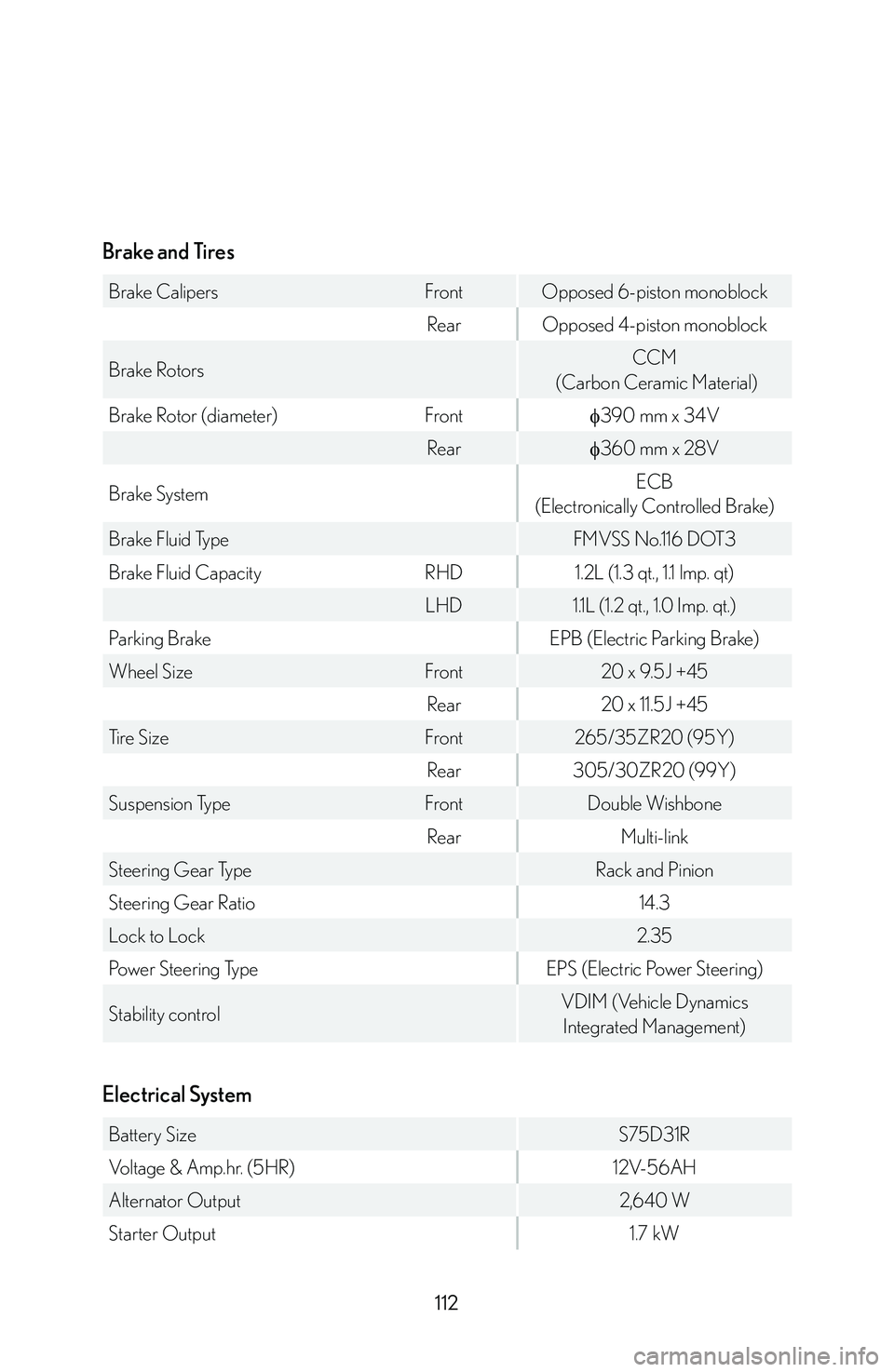
112
Brake and Tires
Brake Calipers FrontOpposed 6-piston monoblock
Rear Opposed 4-piston monoblock
Brake Rotors CCM
(Carbon Ceramic Material)
Brake Rotor (diameter) Front
f390 mm x 34V
Rear f360 mm x 28V
Brake System ECB
(Electronically Controlled Brake)
Brake Fluid Type FMVSS No.116 DOT3
Brake Fluid Capacity RHD1.2L (1.3 qt., 1.1 lmp. qt)
LHD 1.1L (1.2 qt., 1.0 Imp. qt.)
Parking Brake EPB (Electric Parking Brake)
Wheel Size Front20 x 9.5J +45
Rear 20 x 11.5J +45
Tire Size Front265/35ZR20 (95Y)
Rear 305/30ZR20 (99Y)
Suspension Type FrontDouble Wishbone
Rear Multi-link
Steering Gear Type Rack and Pinion
Steering Gear Ratio 14.3
Lock to Lock 2.35
Power Steering Type EPS (Electric Power Steering)
Stability control VDIM (Vehicle Dynamics
Integrated Management)
Electrical System
Battery Size S75D31R
Voltage & Amp.hr. (5HR) 12V-56AH
Alternator Output 2,640 W
Starter Output 1.7 kW
Page 118 of 128
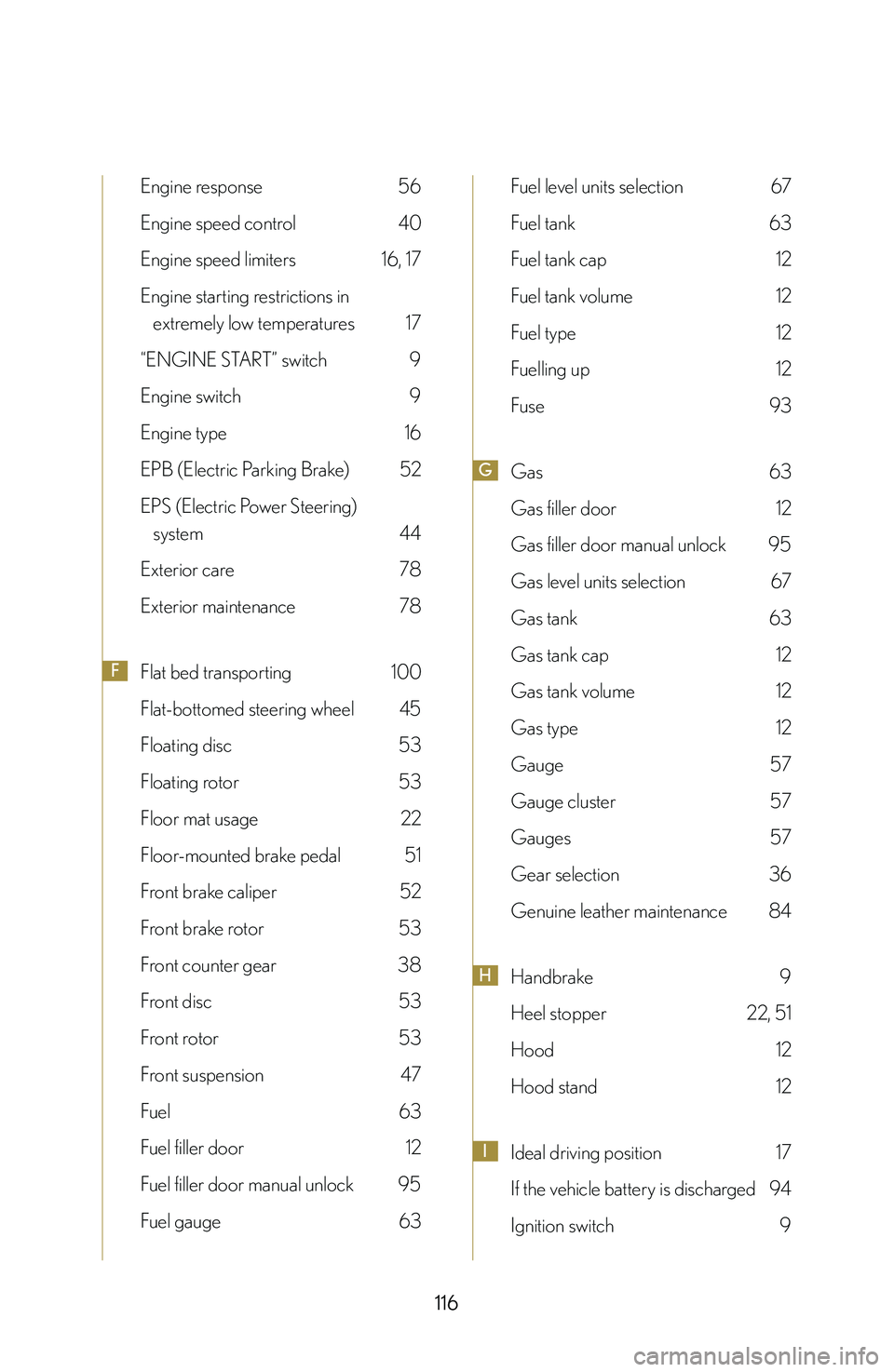
116
Engine response 56
Engine speed control 40
Engine speed limiters 16, 17
Engine starting restrictions in
extremely low temperatures 17
“ENGINE START” switch 9
Engine switch 9
Engine type 16
EPB (Electric Parking Brake) 52
EPS (Electric Power Steering)
system 44
Exterior care 78
Exterior maintenance 78
FFlat bed transporting 100
Flat-bottomed steering wheel 45
Floating disc 53
Floating rotor 53
Floor mat usage 22
Floor-mounted brake pedal 51
Front brake caliper 52
Front brake rotor 53
Front counter gear 38
Front disc 53
Front rotor 53
Front suspension 47
Fuel 63
Fuel filler door 12
Fuel filler door manual unlock 95
Fuel gauge 63
Fuel level units selection 67
Fuel tank 63
Fuel tank cap 12
Fuel tank volume 12
Fuel type 12
Fuelling up 12
Fuse 93
GGas 63
Gas filler door 12
Gas filler door manual unlock 95
Gas level units selection 67
Gas tank 63
Gas tank cap 12
Gas tank volume 12
Gas type 12
Gauge 57
Gauge cluster 57
Gauges 57
Gear selection 36
Genuine leather maintenance 84
HHandbrake 9
Heel stopper 22, 51
Hood 12
Hood stand 12
IIdeal driving position 17
If the vehicle battery is discharged 94
Ignition switch 9